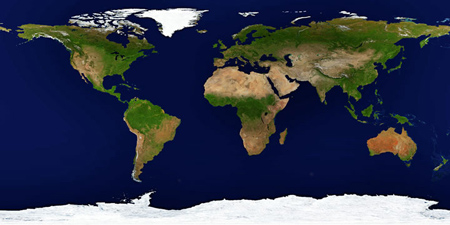Ahmadiyya Times | News Staff |
Source & Credit: The Moscow Times | Dawn.Com
By Staff News selection | February 11, 2020
ALMATY: Long ignored as a myth whipped up by the authorities to justify political repression, a surge in radical Islam in the former Soviet region has become a reality for the West fighting an increasingly tough war in next-door Afghanistan.
Analysts say long-defunct groups like the Islamic Movement of Uzbekistan are regaining force in the impoverished region where ethnic tensions have long simmered under the surface.
"They (militants) are preparing the ground for a long, sustained military campaign in Central Asia," said Ahmed Rashid, a leading Pakistan-based expert on Afghanistan and Central Asia.
"There is now a real threat because the Islamist surge is combined with an economic and political crisis."
A vast region wedged between China, Iran, Afghanistan and Russia, Central Asia found itself on the frontline of global affairs last year when it agreed to host a vital new supply route for Nato forces fighting the Taliban in Afghanistan.
Gripped by deepening gloom about economic stagnation and poverty, the mainly Muslim but secular region has become increasingly susceptible to extremist ideas in past years.
Security analysts say militants, who had long left Central Asia to fight alongside the Taliban, are seeping back into the region to take advantage of its fragile state.
A growing sense of frustration with the lack of basic freedoms has given political undertones to the rise of Islamism in a region which still has no influential opposition parties even after two decades of independence from Soviet rule.
The trend is particularly alarming because of recent parallels with the situation in Yemen, where growing instability has led to fears it may become al Qaeda's next hunting ground.
Acknowledging these risks, Nato Secretary-General Anders Fogh Rasmussen has urged for more engagement with Central Asia.
"If Afghanistan becomes a safe haven for terrorists they could easily spread through Central Asia to Russia," he said last weekend. "Of course Afghanistan is not an island. There is no solution just within its borders."
INFILTRATION
First alarm bells rang in Central Asia last year when Uzbek, Tajik and Kyrgyz troops fought gangs they described as terrorist - around the time when the security situation in northern Afghanistan deteriorated sharply.
"It does not matter who exactly was behind those attacks. It still means instability, that something's going on," said one Western diplomat. "It is certainly something we are watching."
Who are these militants and why are they coming back?
"The reason is that they (have), first of all, done enough fighting for other people. They now want to fight for their own country ," said Rashid, the Central Asia analyst.
"The real threat now is the fact that they are trying to infiltrate back into Central Asia...They are trying to infiltrate weapons, ammunition and men back into Central Asia."
The IMU is shrouded in secrecy and its size is unclear. Its goal is to topple Uzbek President Islam Karimov, who has tolerated no opposition during his two decade long rule.
Another target is Tajik leader Imomali Rakhmon who led pro-Russian forces against Islamists in a civil war in the 1990s. In the West, both are accused of mass rights violations.
The Internet abounds with video clips, some as recent as this month, by groups such as the Islamic Jihad Union, believed to have been founded by breakaway IMU fighters.
One Uzbek-language video, posted on YouTube, shows a desert training facility where dozens of children in black Taliban-style turbans, clutching AK-47s, learn how to shoot.
"Oh children of mujahideen! You are the future warriors of Allah!" says the narrator. Complete with Russian subtitles, it clearly targets the Russian speaking audience of Central Asia.
Anything from the death of long-serving leaders to natural disasters can prompt fighters into action, analysts say.
"We should be looking at potential triggers," said Rashid. "The death of Karimov or Rakhmon, or a power struggle in either of these countries, a major natural disaster, growing hunger or an economic collapse. These could prove the trigger for social unrest which the IMU would take advantage of."
POVERTY
Hizb ut-Tahrir is another group accused of terror activities in Central Asia. It says it has tens of thousands of members in the region but stresses its methods are entirely peaceful.
"It is the Central Asian regimes that continue terrorising their people," said Taji Mustafa, its representative in London. "Since the declaration of the West's so-called 'war on terror', Central Asian governments have used it as a convenient umbrella to pursue, arrest and torture their political opponents."
Central Asia-watchers believe home-grown fundamentalism has been on the rise for some years, spurred by the latest economic crisis which has left millions of migrant workers without jobs.
Official data for the entire region is not available but in Tajikistan, the poorest ex-Soviet republic, economic growth more than halved in 2009 to 3.4 per cent from 7.9 per cent in 2008.
In Kyrgyzstan, another potentially volatile nation, economic growth fell to 2.3 per cent last year from 8.4 per cent in 2008.
"The financial crisis and the return of labour migrants sparked predictions of unrest, intensifying the concern that radical Islamists had been making inroads into the labour diaspora," the International Crisis Group said in a report.
"Insecurity is growing, in part domestically generated, in part because of proximity to Afghanistan; infrastructure is collapsing, weak economies are slipping still further."
Read the original article here: Radical Islam casts shadow over Central Asia














No comments:
Post a Comment
Thank you for your comments. Any comments irrelevant to the post's subject matter, containing abuses, and/or vulgar language will not be approved.